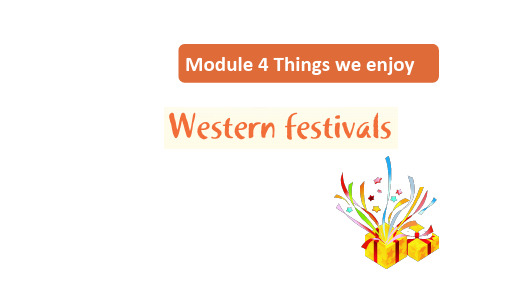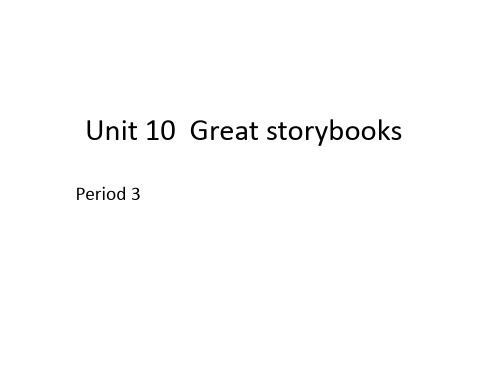【牛津上海版】六下:Module4Unit10《Greatstorybooks》公开课课件
- 格式:pdf
- 大小:5.17 MB
- 文档页数:50

《Unit 10 Great storybooks》教学设计教学目标设计教学策略设计学习评价设计【主要内容】1. Check students ‘homework: read the name of the books and match the stories with the books.【评价反馈】小组评价【主要内容】1. Read and answer. The teacher asks students to read paragraph 1 and 2, and then answer the questions.2. Read and retell. Ask students to find the key words in Para 3 and 4, and then retell the test with your own words.3. Do a survey. Ask students to do a survey about the classmate’s favorite story and make a report.【评价反馈】1.教师评价2.学生评价【主要内容】1. Find some Chinese classical books and share to our classmate.2. Make a reading card about your favorite Chinese stories.【评价反馈】1.组长评价2.教师评价教学过程设计【激趣导入】 1.The teacher shows some pictures about students reading books in ourschool.2. Ask the question “What is he thinking about?” “Do you like reading?”“What kind of books does you like reading?”【设计意图】1.通过图片引出本课主题。




Module 4 Things we enjoyUnit 10 Great storybooks教案2教学目标:〔1〕知识目标:能够熟练运用Do you remember the story…? He╱She wrote a lot of interesting fairy tales and stories. Children around the world enjoy reading his stories等句子,并且能够听、说、认读写collect ,emperor, remember.〔2〕能力目标:能够熟练的运用所学句子,能够掌握询问你还记得什么故事与答复,同时在学句子中学会新单词,学会新的句子运用。
〔3〕情感目标:理解小故事中包含大道理。
教学重点:听懂、会说:Do you remember the story…? He╱She wrote a lot of interesting fairy tales and stories. Children around the world enjoy reading his stories等句子,能够听、说、认读写词组collect ,emperor, remember.在问答题目练习中能够及时反响,补充未完成的句子。
将问题清晰答复。
教学难点:新句子较为难以记忆,句子容易弄混,学生记忆困难。
学生恐难以记住。
教学准备:ppt课件,教案。
教学设计:Lead-in.T:同学们有听过什么故事吗?S1….〔老师开场提问学生问题,问题贴近学生对学生进行提问。
〕〔设计意图:利用同学们所熟悉的东西吸引同学们的注意力,同时引起同学们答复以下问题的兴趣,为接下来句子的学习增强趣味性。
〕Step1. PresentationLet’s learn some new phrases简单的用图文并展的方式首先将新单词引入,教同学识读单词collect ,emperor, remember 〔设计意图:直接的语音教学让学生牢记单词发音,为接下来句子的运用打下根底。

6B Unit 10 Great storybooks单元教学目标:1能在语境中正确运用本单元的核心词汇,复习已学相关核心词汇。
2 能简单介绍自己喜欢的经典故事或名著。
3 初步了解句子语调的基本知识,能用正确的语调朗读句子。
4了解著名童书的相关背景,培养阅读的兴趣。
教学重点:1 词汇学习:blow off, take off2 句型复习:Andersen wrote the stories.Children around the world enjoy reading his stories.3 语音学习:初步了解陈述句、一般疑问句和特殊疑问句的语调。
教学难点:1 经典故事或名著中人名、书名等的发音。
第一课时教学目标:学生能运用适当的阅读策略,了解三本童话书及其作者。
学生能介绍和评价自己所喜欢的经典故事,并且能够复述课文。
运用百科全书或网络等资源查寻有关安徒生、格林兄弟及伊索的作品,师生相互交流。
能善于抓住机会与同学交流合作,丰富知识。
加强对西方著名作家及其文学作品的了解。
通过本课的学习,引导、教育学生要多读书、读好书。
通过读书吸收前人的智慧,不断丰富学识和提高自身素质。
教学重难点:句型复习:Andersen wrote the stories.Children around the world enjoy reading his stories.教学方法与手段:本节课我采用导学自悟法,对话法进行教学。
采用PPT课件,卡片,录音机作为教学辅助手段。
使用教材构想:本节课学生在对课文进行整理,理解基础上,构建思维导图,并根据思维导图进行问答,介绍自己喜欢的作品。
教学方法和过程:Pre-task preparations1 用图片的形式展示一些童书的封面,让形式试着说说这些书名,中英文均可。
同时出示这几个作者的照片。
T:(show the covers of the books)Look at these books. Did you read th em?S1:Yes, I did. It’s Andersen’s Fairy Tales...T:(show some pictures of the writers)Do you know who wtote the se books? These are the writes. Who is he?S2:He’s Andersen.学生尝试将人物图片和书配对。